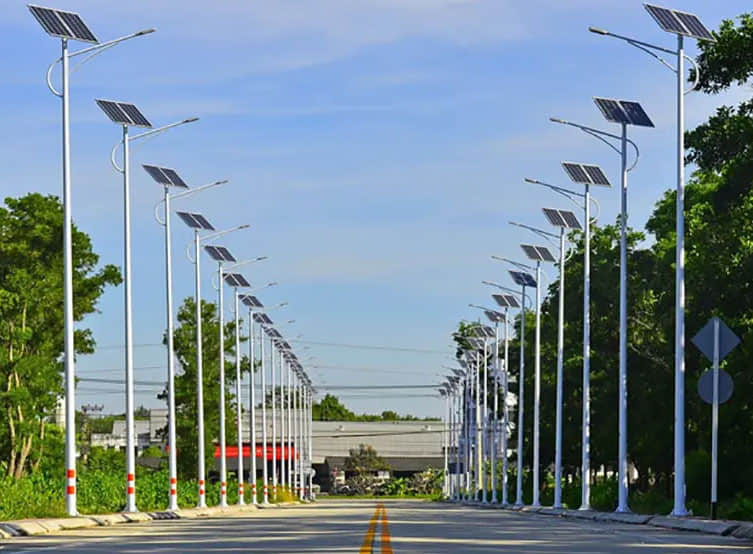
As nations worldwide intensify efforts to transition toward sustainable energy solutions, LED solar streetlights have emerged as a transformative innovation in urban infrastructure. Combining photovoltaic technology with advanced lighting systems, these autonomous units represent both technological progress and environmental responsibility. This article examines the multifaceted advantages and persisting challenges of LED solar streetlights, analyzing their potential to reshape urban landscapes while addressing critical energy concerns.
Environmental Revolution in Urban Lighting
The fundamental advantage of LED solar streetlights lies in their utilization of inexhaustible solar energy. Unlike conventional grid-dependent systems that consume fossil fuels, these installations harness 173,000 terawatts of solar energy continuously striking Earth's surface. Municipalities adopting this technology significantly reduce carbon footprints - a single solar-powered LED unit can prevent 0.5 tons of CO2 emissions annually. When scaled to urban networks, this translates to measurable improvements in air quality and climate impact mitigation. Particularly for developing nations grappling with energy poverty, solar streetlights offer decentralized solutions that bypass costly grid expansion projects.
Engineering Efficiency and Installation Advantages
Modern LED solar systems demonstrate remarkable engineering integration. Traditional streetlight installations require extensive underground cabling, transformer stations, and ongoing grid maintenance - processes consuming 60% more man-hours than solar alternatives. Solar units employ modular designs with integrated photovoltaic panels, lithium-ion batteries, and smart controllers within unified housings. Nairobi's 2019 streetlight modernization project exemplifies this efficiency, deploying 18,000 solar units across 120km of roads within 45 days - 70% faster than conventional methods. The self-contained nature of these systems proves particularly valuable in geographically challenging environments, from flood-prone deltas to earthquake-vulnerable regions.
Economic Sustainability Through Reduced Operational Costs
Financial analyses reveal compelling long-term benefits despite higher initial investments. Solar LED systems eliminate electricity bills that typically constitute 80% of traditional streetlight operational costs. Madrid's municipal data shows 63% cost reduction over 10 years following their 2017 solar conversion initiative. Advanced systems now incorporate self-diagnostic capabilities and remote monitoring, reducing maintenance frequency by 40%. The integration of weather-adaptive dimming algorithms further optimizes energy consumption, extending battery lifespan to 8-10 years through intelligent charge management.
Technical Challenges: Addressing Intermittency
The Achilles' heel of solar lighting remains energy storage limitations. Current lithium-phosphate batteries maintain 80% capacity after 2,000 cycles but struggle with consecutive cloudy days - a critical issue in monsoon regions. Tokyo's 2022 pilot project addressed this through hybrid systems combining solar panels with miniature wind turbines, achieving 94% operational reliability. Emerging technologies like graphene supercapacitors and hydrogen fuel cells show promise for higher-density storage, though commercialization challenges persist. Smart grid integration allowing bidirectional energy flow during surplus periods presents another potential solution currently under testing in California's microgrid networks.
Spatial and Economic Constraints in Implementation
The diffuse nature of solar radiation necessitates large surface areas for energy collection - a significant hurdle in dense urban environments. Seoul's vertical panel installations on building facades adjacent to streets demonstrate innovative spatial adaptation. However, the 25-22% efficiency ceiling of commercial photovoltaic cells continues to limit energy yield. Economically, while panel prices have dropped 89% since 2010, complete solar streetlight systems remain 40-60% costlier than conventional alternatives. Developing nations often require international financing mechanisms, as seen in Rwanda's World Bank-backed national solar streetlight program.
Innovation Pathways and Future Outlook
Material science breakthroughs are gradually overcoming current limitations. Perovskite solar cells achieving 33.7% efficiency in lab conditions and transparent solar panels for dual-purpose applications signal imminent commercial advancements. The integration of IoT technologies enables predictive maintenance and real-time energy optimization - Shenzhen's smart solar streetlights reduced energy waste by 35% through traffic-adaptive lighting algorithms. As manufacturing scales and recycling infrastructures mature, lifecycle costs are projected to reach parity with conventional systems by 2030 according to International Energy Agency forecasts.
The evolution of LED solar streetlights embodies humanity's quest for harmonious coexistence with nature's rhythms. While technical and economic barriers persist, the convergence of renewable energy technologies, smart city frameworks, and circular economic principles charts a clear path toward sustainable urban illumination. As these systems become testbeds for energy innovation, they illuminate more than streets - they light humanity's way toward an energy-resilient future.
 English
English

